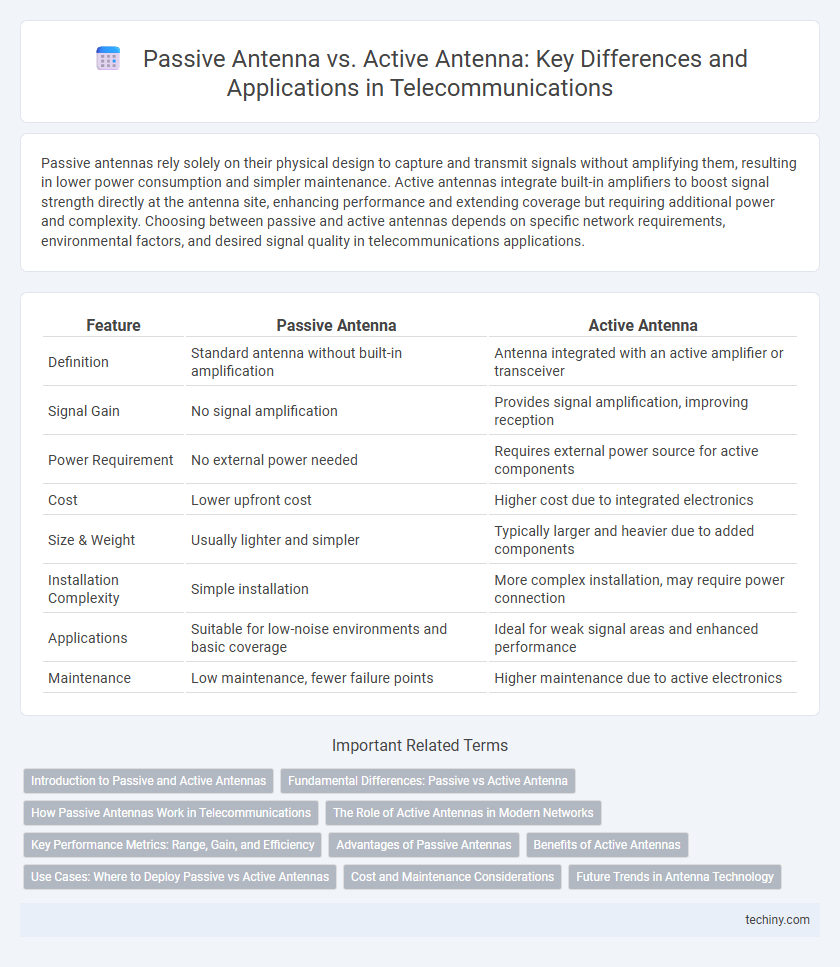Passive antennas rely solely on their physical design to capture and transmit signals without amplifying them, resulting in lower power consumption and simpler maintenance. Active antennas integrate built-in amplifiers to boost signal strength directly at the antenna site, enhancing performance and extending coverage but requiring additional power and complexity. Choosing between passive and active antennas depends on specific network requirements, environmental factors, and desired signal quality in telecommunications applications.
Table of Comparison
| Feature | Passive Antenna | Active Antenna |
|---|---|---|
| Definition | Standard antenna without built-in amplification | Antenna integrated with an active amplifier or transceiver |
| Signal Gain | No signal amplification | Provides signal amplification, improving reception |
| Power Requirement | No external power needed | Requires external power source for active components |
| Cost | Lower upfront cost | Higher cost due to integrated electronics |
| Size & Weight | Usually lighter and simpler | Typically larger and heavier due to added components |
| Installation Complexity | Simple installation | More complex installation, may require power connection |
| Applications | Suitable for low-noise environments and basic coverage | Ideal for weak signal areas and enhanced performance |
| Maintenance | Low maintenance, fewer failure points | Higher maintenance due to active electronics |
Introduction to Passive and Active Antennas
Passive antennas operate without internal amplification, relying solely on external radio frequency signals for transmission and reception, making them cost-effective and energy-efficient. Active antennas incorporate built-in amplifiers or signal processing components, enhancing signal strength and quality in environments with weak or obstructed transmissions. Understanding the differences between passive and active antennas is essential for optimizing network performance in telecommunications infrastructure.
Fundamental Differences: Passive vs Active Antenna
Passive antennas operate without built-in amplification, relying solely on their physical structure to transmit or receive signals, resulting in lower power consumption and simpler design. Active antennas incorporate integrated amplifiers that boost signal strength directly at the antenna, enhancing performance in weak signal environments but increasing power requirements and complexity. Fundamental differences lie in signal amplification presence, power usage, and application scenarios, with passive antennas favored for simplicity and active antennas for improved reception quality.
How Passive Antennas Work in Telecommunications
Passive antennas in telecommunications function by relying solely on the electromagnetic waves they receive or transmit without any built-in amplification or signal processing components. They operate by capturing radio frequency signals and directing them to a receiver or radiating signals from a transmitter using elements like dipoles and reflectors, maintaining signal integrity through their physical design. Passive antennas offer advantages in terms of simplicity, durability, and low maintenance, making them essential for various communication systems that require stable, reliable connectivity without active power consumption.
The Role of Active Antennas in Modern Networks
Active antennas in modern telecommunications networks integrate embedded amplification and signal processing components, enhancing signal strength and improving overall network efficiency. Unlike passive antennas that rely solely on external amplification, active antennas reduce noise and boost performance in complex urban environments and 5G deployments. Their ability to support beamforming and dynamic beam steering enables higher data throughput and better coverage in dense network topologies.
Key Performance Metrics: Range, Gain, and Efficiency
Passive antennas rely solely on their physical design to capture and transmit signals, typically offering high efficiency but limited gain and range compared to active antennas. Active antennas integrate amplifiers to boost signal strength, enhancing range and gain significantly while often consuming more power and potentially introducing noise that can affect overall efficiency. Key performance metrics show passive antennas excel in low-noise environments with higher efficiency, whereas active antennas provide superior range and gain in scenarios that demand amplified signal reception.
Advantages of Passive Antennas
Passive antennas offer superior reliability due to their simpler design with no need for external power sources, reducing maintenance and operational costs. They provide consistent performance across a wide frequency range without signal distortion or amplification noise, ensuring cleaner signal transmission. Their robustness and durability make them ideal for harsh environmental conditions, extending the lifespan of telecommunication infrastructure.
Benefits of Active Antennas
Active antennas integrate amplification and signal processing components directly within the antenna system, enhancing signal strength and improving overall network performance in telecommunications. They enable better noise reduction and extended coverage compared to passive antennas, resulting in higher data throughput and more reliable connectivity. These advantages make active antennas particularly beneficial for advanced cellular networks like 5G, where signal quality and efficient spectrum utilization are critical.
Use Cases: Where to Deploy Passive vs Active Antennas
Passive antennas are ideal for urban and rural deployments where simplicity, durability, and low maintenance are critical, supporting basic signal transmission without requiring external power. Active antennas suit advanced network environments like 5G and LTE small cells, where integrated amplification and signal processing enhance coverage and capacity in high-density areas. Deployment decisions depend on factors such as power availability, desired signal quality, and the complexity of the telecommunications infrastructure.
Cost and Maintenance Considerations
Passive antennas incur lower initial costs and require minimal maintenance due to the absence of integrated electronics, making them cost-effective for long-term deployments. Active antennas, incorporating amplifiers and transceivers, involve higher upfront investment and ongoing maintenance expenses to ensure optimal performance and reliability. Evaluating total cost of ownership and maintenance complexity is essential when choosing between passive and active antenna systems in telecommunications infrastructure.
Future Trends in Antenna Technology
Future trends in antenna technology emphasize integration of active antennas with advanced materials and intelligent signal processing to enhance 5G and 6G network performance. Passive antennas continue to be valued for their simplicity and low power requirements but face limitations in adaptability and beamforming capabilities compared to active antenna systems. Enhanced MIMO configurations and software-defined antennas are driving next-generation telecommunications by enabling dynamic spectrum use and improved network efficiency.
Passive Antenna vs Active Antenna Infographic

 techiny.com
techiny.com